WINDERMERE
A view on the lakeshore at The Ferry House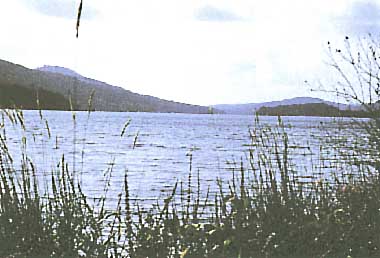
Photo: T. Nakajima
A. LOCATION
- Cumbria, UK.
- 54:20N, 2:57W; 39 m above sea level.
B. DESCRIPTION
-
Windermere is the largest of many picturesque lakes formed by the activity of the Pleistocene ice sheet in the Lake District National Park of northwest England. The park is studded not only with lakes but also with peaks including the highest in England (Sca Fell,978 m) and with historical and archeological relics, producing a very attractive landscape.
The lake is long and narrow from the north to the south, and an island in the central part divides the whole lake into the north and the south basin. Hilly highland stretches behind the shoreline and is used for grazing grounds and woodlands. There are two towns, Ambleside and Windermere, along the northeastern shore. The Freshwater Biological Association's Windermere Laboratory established in 1902 is situated in the midst of western shore.
There are so many lakes, Rydal Water, Grassmere, Esthwaite Water and so forth, in the drainage basin, and the water of these lakes flows into Windermere. Although the pH value of rain water in this area averages 4.4, that of lake water has been very stable since 1928 around 7.0. The present trophic level of the lake is mesotrophic, but eutrophication is proceeding gradually rowing to the influx of nutrients from farms and residential areas.
C. PHYSICAL DIMENSIONS
| Surface area [km2] | 15 |
| Volume [km3] | 0.315 |
| Maximum depth [m] | 64 |
| Mean depth [m] | 21.3 |
| Water level | Unregulated |
| Length of shoreline [km] | 17 |
| Residence time [yr] | - |
| Catchment area [km2] | 231 |
D. PHYSIOGRAPHIC FEATURES
D1 GEOGRAPHICAL- Bathymetric map: Fig. EUR-11-01.
- Names of main islands: Belle.
- Number of outflowing rivers and channels (name): 1 (Leven R.)(3).
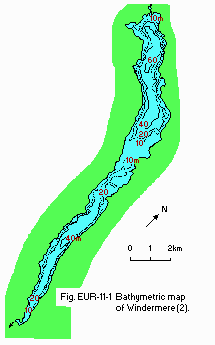
Bathymetric map (2).
D2 CLIMATIC (4)
- Climatic data at Manchester*, 1951-1980
| Mean temp. [deg C] | ||||||||||||
| Jan | Feb | Mar | Apr | May | Jun | Jul | Aug | Sep | Oct | Nov | Dec | Ann. |
|---|---|---|---|---|---|---|---|---|---|---|---|---|
| 3.7 | 3.9 | 5.7 | 8.1 | 11.4 | 14.3 | 15.6 | 15.6 | 13.6 | 10.6 | 6.4 | 4.7 | 9.5 |
| Precipitation [mm] | ||||||||||||
| 67 | 52 | 51 | 50 | 60 | 63 | 78 | 85 | 76 | 69 | 77 | 78 | 805 |
| * Circa 110 km south of the lake. | ||||||||||||
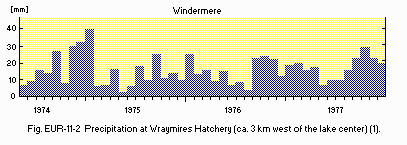
Precipitation at Wraymires Hatchery (ca. 3 km west of the centre of the lake)(1).

Radiation (weekly means). Open bar 1977, shaded bar 1978 [cal cm-2 day-1](5).
- Water temperature [deg C](6)
| Wray Castle Boathouse, The Ferry House, 1933-1975 | ||||||||||||
| Depth [m] | Jan | Feb | Mar | Apr | May | Jun | Jul | Aug | Sep | Oct | Nov | Dec |
|---|---|---|---|---|---|---|---|---|---|---|---|---|
| S* | 4.8 | 3.9 | 4.8 | 7.2 | 11.1 | 15.8 | 17.4 | 17.3 | 15.1 | 11.8 | 8.4 | 6.2 |
| * Surface. | ||||||||||||
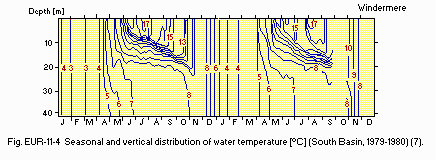
Seasonal and vertical distribution of water temperature [deg C](South Basin, 1979-1980)(7).
- Freezing period: None.
- Mixing type: Monomictic.
- Notes on water mixing and thermocline formation
The thermocline is formed from June to early November.
E. LAKE WATER QUALITY
E2 pH| South Basin, 1974-1977 | ||||||||||||
| Depth [m] | Jan | Feb | Mar | Apr | May | Jun | Jul | Aug | Sep | Oct | Nov | Dec |
|---|---|---|---|---|---|---|---|---|---|---|---|---|
| 0-10 | 7.0 | 7.0 | 7.0 | 7.2 | 7.3 | 7.3 | 7.5 | 8.3 | 7.3 | 6.9 | 6.9 | 6.9 |
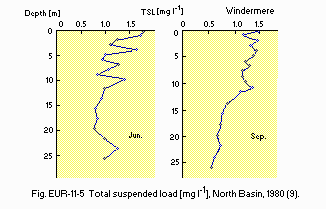
Total suspended load [mg l-1], North Basin, 1980 (9).
E4 DO: Fig. EUR-11-06.
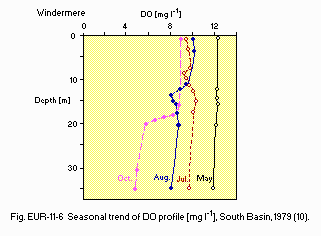
Seasonal trend of DO profile [mg l-1], South Basin, 1979 (10).
E6 CHLOROPHYLL CONCENTRATION: Fig. EUR-11-07.

Chlorophyll a concentration, South Basin, 0.7 m [micro g l-1](10).
E7 NITROGEN CONCENTRATION: Fig. EUR-11-08 and 09.
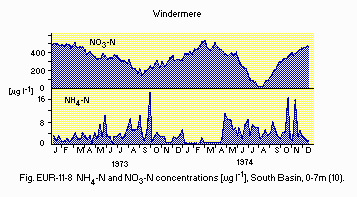
NH4-N and NO3-N concentrations [micro g l-1], South Basin, 0-7 m (10).
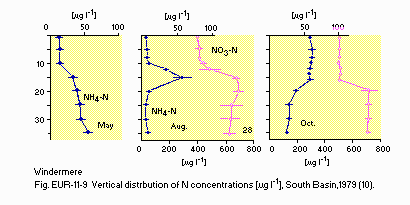
Vertical distribution of N concentrations [micro g l-1], South Basin, 1979 (10).
E8 PHOSPHORUS CONCENTRATION: Fig. EUR-11-10 and 11.
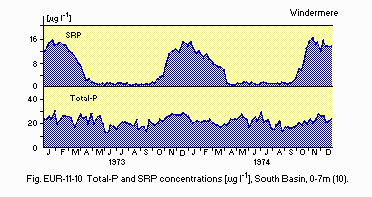
Total-P and SRP concentrations [micro g l-1], South Basin, 0-7 m (10).
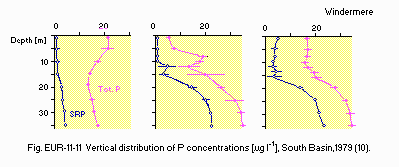
Vertical distribution of P concentrations [micro g l-1], South Basin, 1979 (10).
E10 PAST TRENDS: Fig. EUR-11-12.
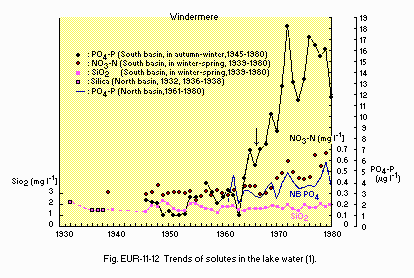
Trends of solutes in the lake water (1).
F. BIOLOGICAL FEATURES
F1 FLORA- Emerged macrophytes (11)
Phragmites australis, Typha angustifolia, Scirpus lacustris, Phalaris arundinacea, Carex elata. - Floating macrophytes (11)
Nymphaea sp., Potamogeton natans. - Submerged macrophytes (11)
Potamogeton perfoliatus, P. gramineus, Elodea canadensis, E. nuttallii, Myriophyllum alterniflorum. - Phytoplankton (7, 9, 12)
Asteronella formosa, Cosmarium spp., Tabellaria flocculosa, Fragilaria crotonensis, Cyclotella meneghiniana, Oscillartoria limnetica, Melosira italica.
- Zooplankton: Cyclops abyssorum, Mesocyclops leuckarti (13).
- Benthos (14, 15)
Isopoda (Ascellus aquaticus), Platylminthes (Dendrocoelum lacteum), Neuroptera (Sialis lutaria), Ephemeroptera (Caenis sp.), Crangonyx, Gammarus, Oligochaetes, Chironomids. - Fish (16)
Salvelinus alpinus, Salmo trutta, Anguilla anguilla, Phoxinus phoxinus, Perca fluviatilis, Esox lucius, Salmo salar, Rutilus rutilus, Scardinius eryhrophthaimus, Tinca tinca, Cottus gobio, Noemacheilus barbatulus, Gasterosteus aculeatus.
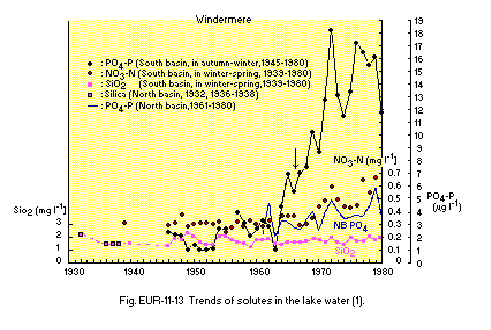
Biomass of zooplankton [mg l-1], South Basin (10).
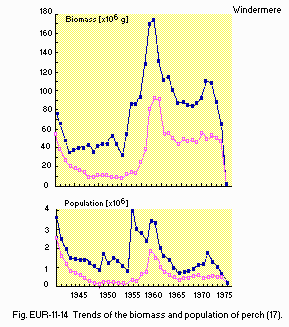
Trends of the biomass and population of perch (17).
a
N. SOURCES OF DATA
- Sutcliffe, D. W., Carrick, T. R., Heron, J., Rigg, E., Talling, J. F., Woof, C. & Lund, J. W. G. (1982) Long-term and seasonal changes in the chemical composition of precipitation and surface waters of lakes and tarns in the English Lake District. Freshwater Biol., 12: 451-506.
- Ramsbottom, A. E. (1976) Depth Charts of the Cumbrian Lakes. Freshwater Biological Association Scientific Publications, No. 33. 39 pp.
- Hutchinson, G. E. (1957) A Treatise on Limnology, Vol.1. Part 1. Geography and Physics of Lakes. John Wiley & Sons, Inc., New York.
- Tokyo Astronomical Observatory (ed.)(1986) Chronological Scientific Tables, 1007 pp. Maruzen Co., Tokyo.*
- Davison, W., Heaney, S. I., Talling, J. F. & Rigg, E. (1980) Seasonal transformations and movements of iron in a productive English lake with deep-water anoxia. Schweiz. Z. Hydrol., 42: 196-224.
- Kipling, C. & Roscoe, M. E. (1977) Surface Water Temperature of Windermere (1933-1975). Freshwater Biological Association Scientific Publications, No. 2, pp. 60.
- Reynolds, C. S., Marison, H. R. & Butterwick, C. (1982) The sedimentary flux of phytoplankton in the south basin of Windermere. Limnol. Oceanogr. 27: 1162-1175.
- Carrick, T. R. & Sutcliffe, D. W. (1982) Concentrations of Major Ions in Lakes and Tarns of the English Lake District (1953-1978). Freshwater Biological Association Scientific Publications, No. 16, 170 pp.
- Scholkovitz, E. R. & Copland, D. (1982) The major-element chemistry of suspended particles in the north basin of Windermere. Geochim. Cosmochim Acta, 46: 1921-1930.
- George, D. G. (1981) The spatial distribution of nutrients in the South Basin of Windermere. Freshwater Biol., 11: 405-424.
- Stokoe, R. (1983) Aquatic Macrophytes in the Tarns and Lakes of Cumbria. Freshwater Biological Association Scientific Publications, No. 18. 60 pp.
- Reynolds, C. S. (1980) Phytoplankton assemblages and their periodicity in stratifying lake systems. Holarct. Ecol., 3: 141-159.
- Smyly, W. J. P. (1978) Strategies for co-existence in two limnetic cyclopoid copepods. Verh. Internat. Verein. Limnol., 20: 2501-2504.
- Marcus, J. H., Sutcliffe, D. W. & Willoughby, L. G. (1978) Feeding and growth of Asellus aquaticus (Isopoda) on food items from the littoral of Windermere, including green leaves of Elodea canadensis. Freshwater Biol., 8: 505-519.
- Macan, T. T. & Silva, P. K. (1979) On the occurrence of Dendrocoelum lacteum (Muller) and Asellus aquaticus (L.) as predator and prey in the stony substratum of Windermere. Arch. Hydrobiol., 86: 95-111.
- Bagenal, T. B. (1982) Experimental manipulations of the fish populations in Windermere. Hydrobiologia, 86: 201-205.
- Craig, J. F., Kipling, C., Le Cren, E. D. & McCormack, J. C. (1979) Estimates of the numbers, biomass and year-class strengths of perch (Perca fluviatilis L.) in Windermere from 1967 to 1977 and some comparisons with earlier years. J. Animal Ecol., 48: 315-325.
* Printed in Japanese.


